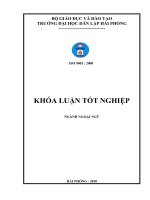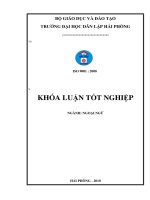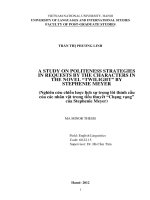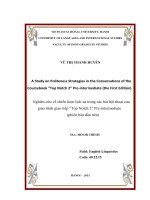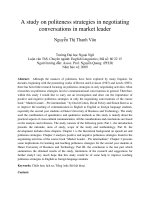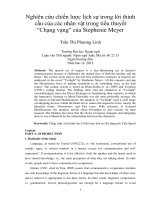A Study on Politeness Strategies in the Conversations of the Course Book “Topnotch 2” Pre-intermediate (the First Edition)
Bạn đang xem bản rút gọn của tài liệu. Xem và tải ngay bản đầy đủ của tài liệu tại đây (161.42 KB, 7 trang )
A Study on Politeness Strategies in the
Conversations of the Course Book “Topnotch 2”
Pre-intermediate (the First Edition)
Vũ Thị Thanh Huyền
Trường Đại học Ngoại ngữ
Luận văn ThS. Chuyên ngành: English Linguistics; Mã số: 60 22 15
Người hướng dẫn: Dr. Đỗ Thị Thanh Hà
Năm bảo vệ: 2013
Keywords: Hội thoại; Giao tiếp; Tiếng Anh
Content
PART A: INTRODUCTION
1. Rationale
Language, generally speaking, is created as a necessary demand of human life with the
crucial aim of communication. Since different people from different cultural and social
backgrounds may have different ways to exchange information and express their attitudes and
opinions, the question of how to successfully communicate in certain contexts, especially in
cross-cultural communication has attracted great attention from linguists and has been widely
discussed so far. It is commonly believed that understanding social conventions and paying
attention to such concepts as politeness and face will definitely allow us to have better
comprehension of a variety of speaking ways by people from different cultures, thus helping
eliminate ethnic stereotypes and misunderstandings. As claimed by Celce-Murcia and Olshtain
(2000), “when learning a second language, one needs to acquire the new culture politeness
framework, which is very different from that of one‟s own culture”. Obviously, students‟ master
of the cultural knowledge in general and strategies to choose the language politely in particular is
supposed to make a valuable contribution to their ability to well communicate with confidence in
any English speaking environment. With such great importance to language competence and
communication skill, politeness strategies are strongly recommended to be included in the course
designs for teaching and learning English as a second language in universities and schools.
Among popular course books for English learners, Top Notch series (with Summit), as
claimed by Pearson Longman, is an award-winning six-level communicative course for adults
and young adults. This course book series have also been used and evaluated by a number of
ESL institutes and teachers in the world. Eslami, Esmaeli, Ghavaminia, and Rajabi (2010)
chosed to evaluate the four mostly instructed courses in Iran English language institutes
namelyTop Notch, Interchange, Headway, and On Your Markbased on Mcdounough and Shaw‟s
(2003) division of course book evaluation into internal and external evaluation. After a thorough
examination, the researchers came to the conclusion that“Top Notch best meets Mcdounough
and Shaw‟s (2003) evaluation criteria”.According to the result of the study by Alemi and
Mesbah (2013), the Top Notch series offered certain benefits to language learners such as
“encouraging thestudents to communicate successfully by giving them lots of opportunities for
interaction, and demonstrating cultural-based aspects not only through lively and authentic
visual images but also without cultural bias” (Alemi&Mesbah, 2013-162).Frommy and my
colleagues ‟personal experiences as English lecturers who have been making use of these books
as text books in the official English teaching program for students at FPT university for nearly
four years, we has got deeply interested in their effective communicative approach with the main
focus on natural and authentic communication, the promotion of integrated language- skills
practice as well as the inclusion of topical themes in interactive conversations. In order to make
better and more effective use of this course book series in teaching, the author of the present
study has had strong desire for chances of conducting anin-depth study on these books‟
communicative approach.
All the aforementioned reasons have encouraged the researcher to work on this study
with the objectives of gaining insights into the positive and negative politeness strategies in the
conversations of the course book “Top Notch 2” by Joan M. Saslow and Allen Ascher -the third
book in the Top Notch and Summit series introduced above.
2. Aims of the study
Firstly, the study is aimed to investigate the politeness strategies utilized in the
conversations of the course book selected. The second aim the study expected to achieve is to
provide teachers with some suggestions for the effective teaching of polite strategies in the book
“Top Notch 2” (the first edition).
3. Objectives of the study
In order to achieve the aims mentioned above, the objectives are specified as follows:
- Identifying and analyzing positive strategies employed in the conversations of “Top
Notch 2” (the first edition).
- Identifying and analyzing negative politeness strategies employed in the conversations of
“Top Notch 2” (the first edition).
- Offering possible implications for teaching positive and negative strategies in an effective
and efficient way with specific exercises related to the content of the course book.
4. Scope of the study
Politeness strategies which can be presented through verbal and nonverbal behaviors also
can be expressed in different ways by different linguists. The research is conducted with no
ambition to study politeness strategies with various approaches but it is mainly based on Brown
and Levinson‟s theoretical framework. The focus of this study is limited to investigating only the
positive and negative politeness strategies in the conversation of “Top Notch 2” (the first
condition) without paying much attention to the nonverbal ones.
5. Significance of the study
Once having been completed, this study would give decent benefits. With respect to
English communication teaching, the study is supposed to serve as noteworthy reference for
creating the suitable methods for teaching politeness strategies in the course book “Top Notch
2”.As for English learner of this course book, the research hopefully help not only raise the
students‟ awareness of the importance of politeness strategies in cross-cultural communication in
general but also provide them with specific knowledge of politesse strategies accompanied with
their typical words and expressions used in the course book‟s conversation as well as related
exercises and activities for their learning and practising in particular.
6. Design of the study report
Part A: Introduction- presents the rationale, aims, objectives, scope,
methods,significance and design of the study.
Part B: Development- consists of three chapters as follows:
Chapter 1: Theoretical background- lays the theoretical foundation for the research.
Chapter 2: Methodology-details the methods that have been used and the procedures that have
been followed by the researcher.
Chapter 3: Findings and discussion – reports the study‟s finding on which further discussion is
offered
Part C: Conclusion: ends the study by summarizing its main points as well as finding
out the limitation and suggestions for the further studies
The following parts are references and appendix .
REFERENCES
1) Alemi, Minoo. &Mesbah, Zahra. (2013). “Textbook evaluation based on the ACTFL
standards: The case of Top Notch series”. Iranian EFL Journal, 9(1), 162-171.
2) Behm, J. (2008). A contrastive analysis of politeness: requests and refusals in German
and English. GRIN Publishing GmbH.
3) Brown, P. & Levinson, S. (1987 [1978]). Politeness: some universals in language usage.
Cambridge: Cambridge University Press.
4) Canale, M. & Swain, M. (1980). Theoretical bases of communicative approaches to
second language teaching and testing. Applied Linguistics, 1, 1-47.
5) Eelen, G. (2001). A critique of politeness theories. Manchester: St. Jerome Publishing.
6) Eslami, R, A. Esmaeli, S. Ghavamnia, M. &Rajabi, S. (2010). Don‟t judge a book by its
cover: Textbook evaluation in the EFL setting. Journal of international social research,
3(14), 448-461.
7) Kitamura, N. (2000). Adapting Brown and Levinson‟s „politeness‟ theory to the analysis
of casual conversation. School of European, Asian & Middle Eastern Languages &
Studies. University of Sydney: Australia.
8) Kodyat, H. (2001). A Study on Politeness Strategies Used by the Interviewers in a
Foreign Exchange Company. Universitas Kristen Petra. Retrieved from the World Wide
Web at
9) Finch, G. (2000). Linguistic terms and concepts.Houndmills, Basingstone, Hamsphire RG
216 XS and London: Macmillan Press LTD.
10) Goffman, E. (1955). On face-work: An analysis of ritual elements of social Interaction.
Psychiatry: Journal for the Study of Interpersonal Processes,18(3), 213-231. Reprinted in
Goffman, E. (1967). Interaction ritual: essays in face-to-face behavior. Random House.
(2nd ed. with Joel Best, 2005). Aldine Transaction.
11) Gu, Y. (1990) Politeness phenomena in modern Chinese. Journal of Pragmatics 14, 237–
257.
12) Hatims, B. & Mason, I. (1990). Discourse and the Translator. New York: Longman.
13) Holmes, J. (2006). Politeness strategies as linguistic variables. Encyclopedia of Language
and Linguistics, 9.
14) Hymes, D. (1962). The ethnography of speaking. In T. Gladwin and W. Sturtevant (eds.),
Anthropology and human behavior. Washington, D.C: Anthropological Society of
Washington.
15) Hymes, D. (1964). Language in culture and society. Harper and Row: New York.
16) Lakoff, R. (1990). Talking power: the politics of language in our lives. Glasgow: Harper
17) Leech, Geofrey. (1983). Principle Pragmatics. London. Longman.
18) Levinson, S. C. (1997). Pragmatics. Cambridge: Cambridge University Press.
19) Maier, P. (1992). Politeness strategies in business letters by native and non-native English
speakers. English for Specific Purposes, 11(3), 189-205.
20) Meliana, F. (1995). The Study of Politeness Expression in Love Match by Barbara
Steiner. Universitas Kristen Petra
21) Mao, L. R. (1994). Beyond politeness theory: „face‟ revisited and renewed. Journal
ofPragmatics21(5), 451–486.
22) Nickerson, C. (1999). The use of politeness strategies in business letters written by native
speakers of English. In Geluyken, R. &Pelsmarkers, K. (eds) Discourse in Professional
Contexts. Lincom, 127-142.
23) Nguyen, T. P. T. (2010). Politeness strategies in requests in "The Thorn Birds". M.A
Thesis. Faculty of Post-graduate Studies, ULIS, VNU.
24) Nguyen, Q. (2003). Intercultural and cross-cultural communication. VNU Press.
25) Nguyen, T. H. (2010). A study on politeness strategies in the conversational activities of
the course book “Inside out- Pre-intermediate”. M.A Thesis. Faculty of Post-graduate
Studies, ULIS, VNU.
26) Nguyen, T. T. V. (2009). A study on politeness strategies in negotiating conversations in
“Market Leader”. M.A Thesis. Faculty of Post-graduate Studies, ULIS, VNU.
27) Paarlahti, S. (1998). Politeness strategies in business letters written by non-native and
native speakers of English.
28) Pariera, K. (2006). The use of politeness strategies in email discussions about taboo
topics. McNair Online Journal, 2.
29) Pham, T. H. L. (2012). A Study on Politeness Strategies in the Conversational Activities
of the Coursebook“ New English file” (Intermediate). M.A Thesis. Faculty of Post-
graduate Studies, ULIS, VNU.
30) Sari, A. W. (2012). Politeness strategies in conversational closing displayed on a
vocational school‟s English text book entitled "English for SMK 1”. Final project. English
Department. Faculty of Languages and Arts. Semarang State University.
31) Savignon, S. J. (1972). Communicative competence: an experiment in foreign language
teaching. Philadelphia: The Centre for Curriculum Development, Inc.
32) Savignon, Sandra (1997). Communicative competence: theory and classroom practice:
texts and contexts in second language learning (2nd Ed.). New York: McGraw-Hill.
33) Savira, M. (2004). A study of politeness strategies used by the three main female
characters in Friends to identify their personality traits. Universitas Kristen Petra.
Retrieved from the World Wide Web at
34) Schmidt, R. & Richards, J. C. (1980). Speech acts and second language learning. Applied
Linguistics, 1, 129-157.
35) Searle, J. 1969. Speech acts: An essay in the philosophy of language. Cambridge, UK:
Cambridge University Press.
36) Searle, J. (1976). Speech acts. London: Syndics of the Cambridge University Press.
37) Shigemitsu, Y. (2003). Politeness strategies in the context of argument in Japanese debate
show. The academic reports, the Faculty of Engineering, Tokyo Institute of Polytechnic.
Retrieved from the World Wide Web at />03.pdf.
38) Spitzberg, B. H. (1988). Progress and pitfalls in conceptualizing and researching
intercultural communication competence. Paper presented at the Speech Communication
Association Conference, New Orleans, LA.
39) Thomas, J. (1995). Meaning in Interaction. New York: Longman.
40) Tran, T. P.(2011). A study of politeness strategies in the conversational activities of the
coursebook “New Headway” Pre-intermediate. M.A Thesis. Faculty of Post-graduate
Studies, ULIS, VNU.
41) Yuka, A. (2009). Positive politeness strategies in oral communication I textbooks -
Focusing on terms of address.The economic journal of Takasaki city university of
economics, 52 (1), 59-70.
42) Yule, G. (1996). Pragmatics. Oxford: Oxford University Press.
43) Zierhofer, W. (2002). Speech acts and space(s): language pragmatics and the discursive
constitution of the social. Environment and Planning A, 34(8), 1355-1372.
44) Vinagre, M. (2008). Politeness strategies in collaborative e-mail exchanges. Computers &
Education, 50(3), 1022–1036.
45) Vilkki, L. (2006). Politeness, face and facework: current issues. SKY Journal of
Linguistics 19, 322-332. Retrieved from the World Wide Web at
SKY journal.
46) Warhaugh, R. (1988). Introduction to Sociolinguistics. UK: Basil Blackwell.
47) Watts, R. J. (2003) Politeness. Cambridge: Cambridge University Press.


